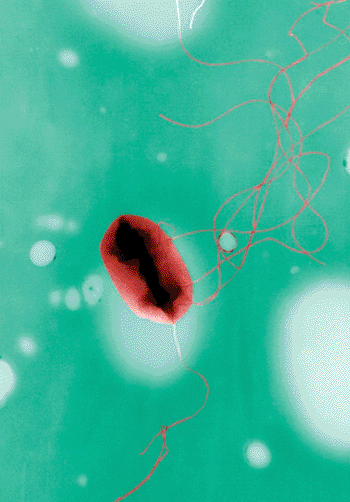Immunofluorescence Assay Detects Virulent Escherichia coli
By LabMedica International staff writers
Posted on 15 Oct 2013
A sensitive and specific detection method for identifying enteropathogenic Escherichia coli (EPEC) and enterohemorrhagic E. coli (EHEC) has been reported. Posted on 15 Oct 2013
Among the methods for detection of virulence factor expression, immunoassays for which polyclonal and or monoclonal antibodies are raised, can be considered the first alternative to either animal use or in vitro culture cells assays.

Image: Transmission electron micrograph of Escherichia coli (Photo courtesy of Elizabeth H. White).
Scientists at Instituto Butantan (Sao Paulo, SP, Brazil) developed a recombinant antibody using the single-chain variable fragment (scFv) approach. They evaluated the sensitivity and specificity of an intimin recombinant antibody (scFv-intimin) using an immunofluorescence assay. A synthetic gene was designed using the scFv-intimin. The intimin adherence-protein gene (eae) encodes for intimin, a 94-kDa outer membrane protein.
The evaluation of scFv-intimin by an indirect immunofluorescence assay test performance implied the use of eae-positive isolates displaying intimin variants, specifically typical EPEC (tEPEC), atypical EPEC (aEPEC), and EHEC, to assess test sensitivity and eae-negative and other Enterobacteriaceae isolates. The prototype tEPEC E2348/69 and enterotoxigenic (ETEC) H10407/E. coli K-12 isolates acted as positive and negative controls, respectively, for assay standardization.
Anti-histidine mouse antibody and goat anti-mouse immunoglobulin G- Fluorescein isothiocyanate (IgG-FITC, Sigma-Aldrich; St. Louis, MO, USA) conjugate were also included as immunofluorescence controls. In all isolates, the eae gene was first assayed by PCR, and the eae positive isolates were confirmed by fluorescent actin staining analysis. A drop of the manipulated bacterial suspension that had also been resuspended with scFv-intimin was placed on a glass slide and observed with a fluorescence microscope (Axioskop-Zeiss; Munich, Germany).
The scFv-intimin immunoassay detected typical EPEC, atypical EPEC, and EHEC isolates with 100% sensitivity and did not detect eae negative isolates, indicating 100% specificity. The authors conclude that immunofluorescence is an effective and rapid method, and scFv-intimin, an excellent tool for the diagnosis of diarrhea caused by EPEC and EHEC and also can be employed in case-control epidemiological surveys. The study was published on October 2, 2013, in the journal Diagnostic Microbiology and Infectious Disease.
Related Links:
Instituto Butantan
Sigma-Aldrich
Axioskop-Zeiss














